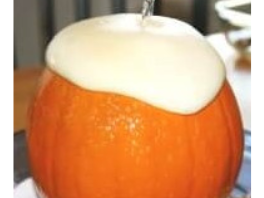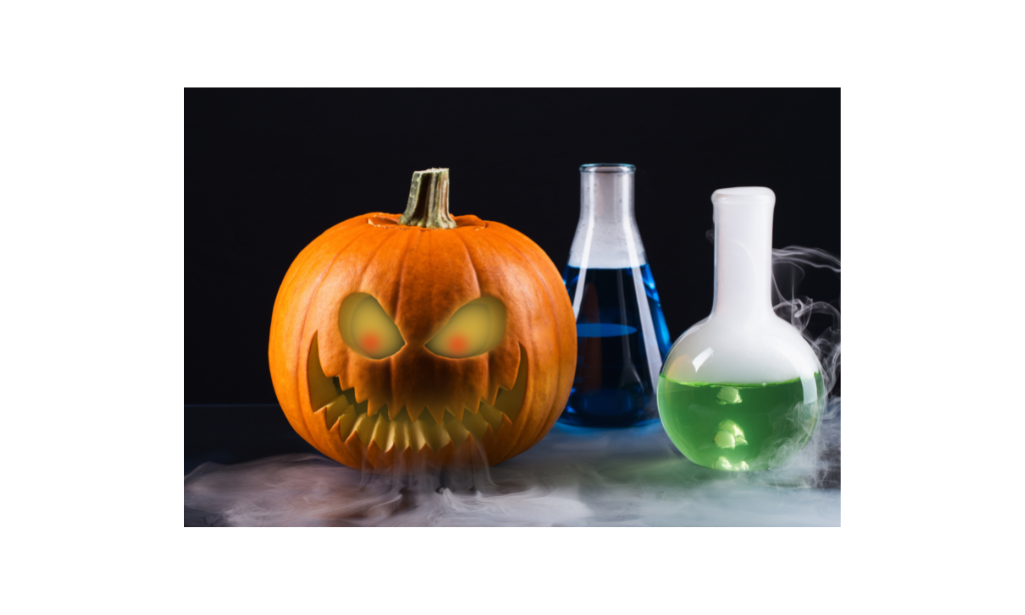We’re well into fall–or what I like to call, hands-down, the best season. Autumn is full of sensory amazement, especially in the Northeast part of the country. The cool, crisp air. The stunning scenery of leaves changing their colors. The smell of burning leaves. The sweetness of apples and apple cider and other apple-y creations. Halloween and scary movies. And, of course, the feel of pumpkin innards (it’s all part of pumpkin science!).
OK, pumpkin guts are pretty disgusting (though the seeds are delicious when seasoned and baked!). But pumpkins are a colorful, beautiful, and spooky symbol of the season, whether they’re used for carving jack-o’-lanterns, displayed outside with corn stalks and hay bales as cozy fall decor, or dissected for scientific purposes. Which is what Today’s Lesson is all about. Pumpkin science! We’re going to take a look at two fun, frightening, and yes, messy, science experiments you and your kids can conduct with pumpkins.
The Pumpkin Volcano
Or the Pump-kano. Or…ok, Pumpkin Volcano.
What You’ll Need
- One pumpkin (the size doesn’t matter–just know that the larger the pumpkin, the more ingredients you’ll need to use…and the bigger mess you’re going to make)
- Small container (cup, bottle, etc.)
- Baking soda
- Vinegar
- Dish soap
- Water
- Food coloring (optional)
Steps
- Cut open the top of the pumpkin and hollow it out–just as you would for a jack-o’-lantern. If your child enjoys sensory play, the gooey innards will be fun for them.
- Place the pumpkin inside a large bowl or tray–you’ll thank me later.
- Place a small container inside the pumpkin. You can use a cup or a small bottle or even just the inside of the pumpkin–whatever fits nicely.
- In the container (or the pumpkin itself, add warm water (mixed with food coloring if you choose) until the container is about ¾ full. Then add about four or five drops of dish soap and a few tablespoons of baking soda.
- When you’re ready for the fun…add ¼ cup of vinegar and get ready for a pumpkin eruption!

Wasn’t that fun? And messy? Let’s try another one!
The Erupting Pumpkin (or what I like to call The Puking Pumpkin)
Just to clarify, this is essentially the same experiment as the Pumpkin Volcano–it’s just more fun to look at when it’s erupting. The same pumpkin science applies, as do most of the ingredients/supplies.
What You’ll Need
- One (or more) pumpkin (I’d probably go a little bigger than the Pumpkin Volcano, because you’re going to carve this one)
- Carving tools or knives (safety first, parents!)
- Baking soda
- Vinegar
- Dish soap
- Food coloring (optional, but recommended here…you’ll see why)
Steps
- Carve your pumpkin(s) with whatever design you’d like. Pro tip: make the mouth fairly large!
- Once carved, add about 1 cup of baking soda to the pumpkin (less if the pumpkin is small-ish).
- Add a few drops of the food coloring and a squirt of dish soap.
- Finally, pour 2 to 3 cups of vinegar into the pumpkin.
- Get your phone/camera ready and move back!

Maybe I’m just a big child, but I found the puking pumpkin to be highly entertaining. And your kids will too. Regardless of age.
The Science
So, what causes the fun “explosion” in the pumpkin? Science, of course. More specifically though, we’re talking about acids and bases.
An acid is a substance that contains hydrogen and is capable of lending a proton (a hydrogen ion) to another substance. A base is a molecule or ion that can take on a hydrogen ion from an acid.
Acids are generally sour in taste. Bases are usually bitter in taste and have a slippery texture. When acids and bases mix, a reaction occurs. In our pumpkin experiments, the vinegar is an acid while the baking soda is a base. More specifically, and importantly, the vinegar is an acid in water. According to STEM Mayhem, the water in the vinegar acts as a host where the base and acid react. When the vinegar is poured onto the baking soda mixture, a chemical reaction occurs, which produces gas. During the reaction, as the baking soda is mixed with the vinegar, the base (baking soda) takes a proton from the acid (vinegar), which causes the baking soda to transform into water and carbon dioxide–the bubbling and fizzing reaction that’s so much fun.
Use this lesson to discuss the acid-base science and some other real-life examples of acid-base reactions such as heartburn being treated with an antacid.
We hope you enjoyed Today’s Lesson! Subscribe to our blog for more fun lesson ideas and creative homeschooling tips and tricks!!







